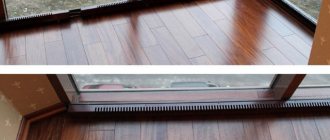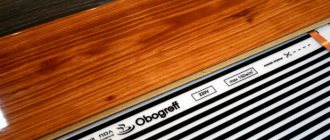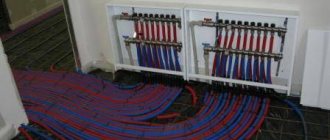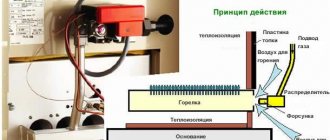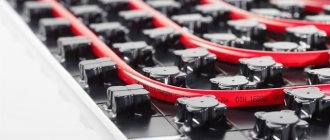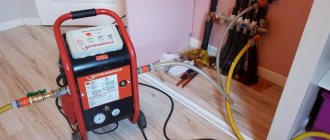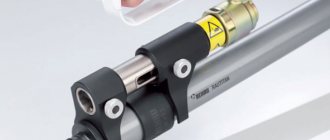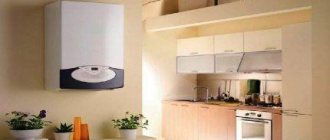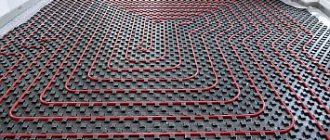In order to economically and effectively warm the base of the floor in the room, you should install a high-quality warm water floor. It will not require labor and costs during operation. At the same time, the required temperature will be constantly maintained in each room. The heating elements must be placed in a heated floor cement screed, which must be poured from a well-prepared mortar. Here you can do everything yourself, observing the proportions, or buy a ready-made mixture for pouring a warm water floor. In any case, the composition of the solution for screeding a water-heated floor will be slightly different.
The essence of dry screed technology for heated floors
As the name implies, “dry” means a light system, without the addition of water and plasticizer.
A heated water floor is a fairly massive structure, and if you use a wet screed, the level of the floor itself increases. It is worth saying that not every room has the required ceiling height to compensate for the lost centimeters. In addition, a wet screed increases the load on the floors of the building. The weight of 1 m² of a heated floor with a concrete screed is 200-300 kg. It is clear that the weight of the structure in a room of 15-17 m² will be serious and not the weight of the house, much less apartments, are designed for such a load. Therefore, many users prefer dry screed.
Dry screed for heated floors can be made in two variations:
- wooden;
- polystyrene.
Based on what materials are used, the name and installation method are determined. In this case, strips and boards made of OSB, gypsum fiber board and chipboard act as the main support. But you can use any other tiled material. For a polystyrene system, the support layer is made of polystyrene boards. Insulating layers are laid directly on this base, in which there are grooves for installing water circuit pipes. The final coating here will be not a monolithic concrete slab, but a stacked structure made from gypsum fiber board sheets.
Thickness
During the work process, many users ask the question: what should be the thickness of the screed for a heated floor?
And this parameter is very important; there are clearly described rules in this regard, the observance of which is beyond doubt:
- The thickness of the screed over the entire area of the room should be identical. Only in this way will uniform heating and high heat transfer be achieved. Under no circumstances should screed be poured under a heated floor until all bulges, holes and folds on the subfloor have been eliminated.
- It is important that the coating is not too thin. Insufficient thickness will affect the uneven heating of the floor, the amount of accumulated heat will be negligible and the surface will cool down very quickly. Also, a thin layer can cause the material to crack.
- It is also unacceptable to use a layer that is too thick, since in such a situation heat, on the contrary, will be retained inside the structure.
Only maintaining balance and precise proportions will allow you to achieve high heating efficiency.
What is the optimal screed thickness for a warm water floor? Fill at least 5 cm from the thermal insulation layer. Otherwise, cracks will appear in the first operating season. For an electrical cable system it is 2.5 cm, for a film cable system it is 1 cm.
How to properly lay a “semi-dry” concrete screed
In order for the concrete layer to be perfectly smooth, you need to position the beacons correctly. The distance between the beacons is left such that the one and a half meter rule can be used. That is, a distance of no more than 140 cm should be maintained between the beacons.
Types of beacons:
- Mortar beacons made of narrow ridges of cement-sand mortar (gypsum cannot be used). Not the most effective method, since the ridges must dry out, and this takes time. In addition, a rule can accidentally “knock down” such pointers.
- Lighthouses made of metal pipes. Pipes or other rigid profiles are strengthened at the required height. A day after laying the concrete, they are removed and the recesses are filled with mortar. Pipes are used several times for this purpose. The only condition is that they must be perfectly even. Both round and rectangular profiles are used.
Galvanized guides for plaster. The stronger the beacons, the better. The optimal size is 1-1.4 cm. After they have performed their function, they can be left in place or removed after the solution has set. Such beacons are disposable. If you have the skills, you can set them as evenly as possible. Strengthen with mortar, adjusting it to the level using a piece of tile or a brick fragment. The distance between the beacons is 40-50 cm. Sometimes they are installed on special supports that can be adjusted.
Immediately before pouring the screed...
Before pouring the screed, a pressure is created in the heated floor that is 2 times higher than the working pressure (if the working pressure is 1.5 atm, then before pouring we build up ~3 atm). That is, when pouring the screed, there must be pressure in the pipes. But the coolant cannot be heated above 25 degrees until the concrete has completely hardened (17...28 days).
It is now common to hide communications in a concrete screed. If you are aiming for this, then all communications must be checked before concreting: electrical - with a tester, hydraulic - with pressure (the pipe has two outlets, one has a plug, the other has a compressor).
Dry screed for heated floors
A reduced concentration of water, introduced in limited quantities into the semi-dry mass, ensures accelerated hardening and a high degree of strength. The main ingredients of the composition for semi-dry base formation:
- Portland cement grade M400.
- Pre-screened coarse sand.
- Fiber fiber introduced in a volume of up to 800 grams per cubic meter of composition.
There are several types of screeds used when installing heated floors
Semi-dry screed for heated floors has many advantages:
- hardens much faster compared to concrete;
- has increased strength;
- acquires operational characteristics with minimal shrinkage;
- does not become covered with a network of cracks;
- resistant to sudden temperature fluctuations.
The disadvantages of a semi-dry composition include:
- Reduced plasticity, requiring significant effort when kneading.
- The need for reliable protection of the hardened mass from moisture absorption.
- The formation of cavities in the semi-dry mixture after laying, associated with uneven compaction.
A feature of Knauf brand dry mixtures used for water heating is that there is no need to use water to prepare the working composition. Enlarged, the “sandwich” consists of the following layers:
- protective polyethylene film that protects the composition from moisture;
- dry composition based on fine expanded clay up to 4 mm in size;
- sheet material forming the finishing coating.
The entire screed is made from dry materials, and it is quite possible to lay a heated floor on a dry screed. No special surface preparation is required for the dry expanded clay mixture. This makes it possible to quickly form a reliable base for protecting heating lines and installing a finishing coating. Advantages of the dry mixture:
- accelerated pace of foundation formation;
- installation of sheet covering after filling with expanded clay chips;
- absence of dirt at the work site;
- simplicity of backfilling, ease of independent implementation of activities;
- improved sound insulation;
- reliable heat retention;
- laying on various types of bases;
- compensation for surface differences;
- low dry weight;
- easy access to heated floor elements.
We invite you to familiarize yourself with the Electric boiler for heated floors in the bathhouse
Disadvantages of dry mix:
- long drying when wet;
- dust formation due to violation of installation technology;
- increased hygroscopicity.
For water and electric heated floors, a semi-dry method of forming a protective layer is used.
Semi-dry screed method. A small amount of water is used for production
It involves the use of the following components:
- Cement grade M300 and higher – 1 part.
- Coarse sand, cleared of impurities - 3 parts.
- Fiber, representing fiber, introduced in an amount of 400–600 g per 1 m³ of solution.
- Add water until the mixture reaches a slightly damp consistency.
The semi-dry composition has pros and cons. The positive aspects of using a semi-dry mixture are:
- accelerated hardening;
- increased strength characteristics;
- slight shrinkage;
- no cracks;
- resistance to temperature changes.
The disadvantages associated with the features of the laying technology include:
- the rigidity of the composition, which is problematic to stir;
- the need to protect the semi-dry mixture from moisture absorption;
- the presence of voids caused by uneven compaction.
Semi-dry coating
Today, many people prefer dry mixture for laying screed. It is less problematic to pour than a cement-sand mixture. This installation method has its own characteristics. The semi-dry mixture is considered stronger than ordinary cement. After pouring, the drying period is much shorter, which makes it possible to finish laying heated floors faster.
Experts say that the material does not crumble or collapse under the influence of heat emanating from the pipes. It is easier and more convenient to work with this type of mixture.
Before laying the semi-dry mixture, you should carefully prepare the base. All debris is removed, the base is laid with a vapor barrier material. If there are deep cracks or depressions, it is recommended to fill them with a viscous cement solution. Rolled materials are laid with an overlap, and it must also overlap the walls. The seams are treated with special tape. The semi-dry mixture is poured onto the finished base.
The mixing proportions that should be used are indicated on the packages of the semi-dry mixture. The consistency of the material should not contain a lot of water. If you squeeze it in your hand, you get a dense lump. Moisture should not flow down your hand. In this way, they check that the ingredients of the mixture are mixed correctly. Very often, fiber fiber is added to the dry mixture to make the coating even more stable. The fiber is well distributed throughout the structure in all directions.
The minimum thickness of the screed will be 4 cm. Its height also depends on the method of laying the pipes themselves and what material they are laid on. The floor and its maximum height can reach 20 cm. If the base for pouring has significant unevenness, the height must be raised significantly. In general, the thickness will be at least 4 cm and no more than 20 cm.
The coating may be destroyed by improper drying methods. Just because you can walk on the floor does not mean the grout is truly dry. A liquid cement-sand mixture 4 cm high takes at least a month to dry. The mixture prepared from dry materials dries within several days, depending on the height of the coating. In order for the material to harden correctly and without cracking, the surface should be moistened with water and covered with film. As a result, the base will not sag, will dry well and will not crack.
The size of the water coating depends on the type of fill and the characteristics of the base. The more significant irregularities on the surface, the higher the structure will be. This happens due to the application of several layers - this is a necessity to achieve the zero level.
Based on experience, experts say that the relative total height of the warm water coating is 10-15 cm, taking into account absolutely all materials used, including the floor covering.
Stages of work on semi-dry screed
Rice. 7. The process of laying semi-dry screed
Using the already mentioned example of semi-dry XPS screed, we will show the sequence and stages of the technological process
Installation of damping tape
It is laid along the entire perimeter of the walls and around columns. It is fixed using its own adhesive layer, or, if there is no such layer, with double-sided tape, foam adhesive or using a stapler (if the wall is plastered). If a waterproofing material (film, foil flooring, etc.) is laid on the subfloor or insulation, then the tape must be folded inside the room, overlapping with the horizontal surface.
Reinforcement
Reinforcing steel mesh is laid on a layer of insulation with overlapping sheets, which are connected with wire. The mesh should be located in the lower third of the screed, but not at the very bottom, but on top of the 1st layer. This height provides, on the one hand, a protective layer of concrete under the metal, and on the other, the ability to lay heated floor pipes using rows of cells as markings.
To do this, after filling the 1st layer and distributing the mixture, the mesh is lifted upward and only then the surface is compacted. When compacting, the mesh does not sink completely into the screed. It is clearly visible when laying pipes or cables.
Preparation of the solution
Since the setting time of the mixture is limited, it is necessary to prepare the solution exactly for laying one layer (bottom or top). Fiber fiber is added to water and then mixed. The consistency of the resulting mass should be similar in plasticity to snow when forming a conditional “snowball”, but water should not be released.
Laying the mixture
From the mortar pump, the screed mixture is supplied to the site in discrete portions into a special absorber receiver standing on a tripod. The mass that spills onto the floor from the damper is distributed around the room using shovels and rakes.
The main team forms the second (top) layer of semi-dry screed immediately after laying the pipes and preparing the second portion of the solution.
Seal
On small objects, compaction of the 1st layer is carried out by trampling. In large rooms, compaction can be done when filling with milling machines. Compaction of the top layer is performed directly during leveling with the rule.
Laying heated floors
When a team of concrete workers leaves the premises, specialists enter it to lay pipes or electric cables for the heated floor. Since this operation does not require a strictly flat plane, it can be started immediately after compaction, without waiting for it to dry - the end of the setting time of the solution is sufficient.
Formation of beacons
This is done after filling the 2nd layer of screed. Unlike wet technology, semi-dry technology does not involve the installation of metal beacons. Areas of compacted screed serve as beacons. Point areas are made using a laser axle builder. Then the master, combining these sites with a rule, creates linear beacons. These guide elements must be formed along the walls and along the centers of the largest spans. The distance between parallel beacons should not exceed the length of the rule.
Rice. 4. Work on semi-dry screed over EPS in a small room
Leveling and compacting the surface
It is carried out by the rule according to the formed beacons. During the operation, a single plane is ensured, all irregularities are cut off, and the entire leveling layer is given the required density.
Grout
Mechanical processing with rotary trowels is carried out during the initial setting of the screed, immediately after its leveling and compaction. The metal disk of the machine cuts off the slightest deviations from flatness and further compacts the concrete layer.
Strength gain
To extend the drying time, it is necessary to slow down the evaporation of moisture. To do this, the surface of the screed is covered with film and left for a period of 1 week to a month (depending on) the temperature in the room, the work plan and the planned type of finishing coating.
Thermal insulation
To prevent heat loss through the ceilings, thermal insulation is used. When choosing it, take into account the heat-shielding properties, on which the overall thickness of the screed depends. On the ground floor, slabs 5 cm thick are used as thermal insulation; if there is an apartment below with heating, insulating layers no more than 2-3 cm can be used.
The heat insulator is taken with a metallized coating. Aluminum foil does not withstand prolonged contact with the screed and is destroyed. It is necessary to use metallized coatings in the form of spraying with lavsan, etc.
Laying thermal insulation for heated floors
Laying the slabs is done without gaps. The resulting cracks are filled with polyurethane foam, all joints are sealed with adhesive tape.
Ratio of concrete mixture components for floor screed
The construction mixture for forming a monolithic floor includes three main components: lime cement, coarse river or quarry purified sand, and clean water. To increase the workability of the mixture, various synthetic additives can be added to the solution, for example, to increase viscosity or plasticity, but a properly mixed solution and a consistent ratio of bulk and liquid materials give excellent results, and the solution perfectly levels and adheres to the prepared floor surface without purchasing additives that will cost a pretty penny.
Building materials markets sell ready-packaged dry concrete mixture for floor screed. Their advantage is that it is possible to more accurately dose the proportions of concrete for floor screed and pour the working surface faster. There is only one drawback of such dry mixtures: they cost 1.5-2 times more than a mixture prepared independently. Therefore, in order to save money (and in individual construction this goal is constantly pursued), when given the task of pouring a floor on the ground at a minimum cost of building materials, the solution is prepared with one’s own resources and resources. In this case, it is necessary to observe the following proportions of concrete for pouring the floor inside a residential or non-residential building (in weight or volumetric proportions):
- One part of cement TsEM I 32.5H PC (M 400) to three and a half parts of river or washed quarry sand, and 6/10 parts of industrial water;
- One part of Portland cement CEM I 42.5H PC (M 500) to four parts of river or quarry sand, and 7/10 parts of industrial water.
The ratio of grades M 400 and M 500 to other components of the composition When mixing concrete, the developer has to independently measure the volumes (weight) of bulk or liquid substances and mix them, so the result (ready-made solution) will be much cheaper than a factory-packaged mixture. For M 400 and M 500, the ratio of components given in the list above will correspond to the concrete grade M 150. A similar grade of concrete is used for the floor in a garage or in other unheated rooms with high humidity.
The solution that will be poured and used outdoors differs in composition and proportions from the solution for indoor use. Screed in open space is constantly exposed to changes in temperature, humidity, weathering, and solar radiation, so its mechanical properties should a priori be better.
High-strength concrete screed for self-leveling floors
| Portland cement, brand | Concrete mortar, brand | Portland cement|sand|crushed stone (weight, kg) | Portland cement|sand|crushed stone (volume, l) | Volume of solution from 10 liters of Portland cement |
| 400 | 100 | 1,0|4,0;6,0|7,0 | 10|41|61 | 78,0 |
| 500 | 1,0|5,0;8,0|8,1 | 10|53|71 | 90,0 | |
| 400 | 150 | 1,0|3,0;5,0|5,7 | 10|32|50 | 64,0 |
| 500 | 1,0|4,0;5,0|6,6 | 10|40|58 | 73,0 | |
| 400 | 200 | 1,0|2,0;8,0|4,8 | 10|25|42 | 54,0 |
| 500 | 1,0|3,0;5,0|5,6 | 10|32|49 | 62,0 | |
| 400 | 250 | 1,0|2,0;1,0|3,9 | 10|19|34 | 43,0 |
| 500 | 1,0|2,0;6,0|4,5 | 10|24|39 | 50,0 | |
| 400 | 300 | 1,0|1,0;9,0|3,7 | 10|17|32 | 41,0 |
| 500 | 1,0|2,0;4,0|4,3 | 10|22|37 | 47,0 | |
| 400 | 400 | 1,0|1,0;2,0|2,7 | 10|11|24 | 31,0 |
| 500 | 1,0|1,0;6,0|3,2 | 10|14|28 | 36,0 |
An example of a concrete structure that will be constantly exposed to all kinds of atmospheric influences on the street is a concrete blind area around the circumference of a house or garage. In this case, the grade of concrete for the garage foundation should be M 150 and consist of the proportions of the components given below.
Blind area around the house
The surface of the finished screed must be ironed with pure cement:
- One part of Portland cement brand CEM I 32.5H PC (M 400) to four parts of river or purified quarry sand, five and a half parts of crushed stone (marble, gravel or granite chips) and 9/10 parts of clean industrial water;
- One part of Portland cement CEM I 42.5H PC (M 500) to 4.1 parts of river or purified quarry sand, five and a half parts of crushed stone (marble, gravel or granite chips) and 7/10 parts of clean industrial water.
For screeds or floors on the ground that do not experience large mechanical and shock loads, marble, gravel or granite chips acting as crushed stone can be replaced with construction rubble: brick waste, furnace or blast furnace slag, waste ceramic building blocks, etc.
Why is only the M 150 brand recommended? It complies with SNiP 2.03.13-88, which states that for pouring concrete screeds, building materials with a compressive strength of ≥ 15 MPa or 150 kgf/cm2 should be used, and these indicators are only suitable for grade M 150.
Recommendations for designing floors SNiP 2.03.13-88
Features of such solutions
Unlike the pouring of simple unheated structures, the operation of a heated floor is accompanied by a complex operating mode. The temperature inside the screed is about 50 °C and drops to 30-35 °C near its surface. Inconstancy of external conditions and frequent changes in regimes lead to consistent destruction of the floor:
- microcracks appear at the base of the floor slab, gradually increasing in size;
- the temperature on the outer surface of the floor and its efficiency are reduced. This is caused by the air in the cracks, which has poor thermal conductivity;
- the growth of cracks causes distortions in the cement layer and leads to damage to the heating elements. When using high-voltage wiring, there is a danger of electric shock, and when pipelines are laid, there is a risk of flooding of the floors located below.
To avoid dangerous deformations in the poured screed, solutions for heated floors must provide the following characteristics:
- minimal porosity . The dense structure improves thermal conductivity and, as a result, heating efficiency;
- low tendency to crack formation . In addition to increasing heating efficiency, this property eliminates bending and damage to pipelines;
- low setting time - the longer the solution hardens, the greater the likelihood of residual stresses occurring while one part of the screed is wet and the other is dry;
- sufficiently high strength so as not to crack during walking, installing and moving furniture, etc.
Read below about the proportions and composition of the mortar for screeding and pouring water heated floors.
Composition of purchased solutions for installing screeds on warm water floors.
The composition of dry mortars for screeding is practically no different from homemade ones. Only we must understand that the proportions of cement and other components in it are accurate, and in the end you will receive a screed of the brand and quality declared by the manufacturer. The most interesting thing is that the granulated slag fraction, the quality of the sand, will be just as high as what you buy separately. Plasticizers are also selected by the manufacturer according to the established database and tests performed! umnyestroiteli.ru The thick-layer self-leveling screed “Glims” has proven itself well in this area. The thickness of which can reach 4 centimeters. This characteristic is irreplaceable when installing a warm water floor* and the base does not lose its primary characteristics than other screeds. It can be used even in rooms with high humidity. If the water floor line breaks, this screed compound will be able to hold water for a long period of time! And everyone should know this about the composition of screeds for warm water floors!
Screeds are divided into three types:
- Fine grinding fraction;
- Average grinding fraction;
- Large grinding fraction.
Screeds with a solution composition of medium and coarse grinding are suitable for monotilizing a water floor. Screeds with finely ground fractions are not used for pouring warm water floors! This is due to the fact that the layer of finely ground stitch solution cannot be made more than 1 centimeter. And in our case we need at least 2 cm.
https://youtube.com/watch?v=fY3jneItmIs
Expansion joints when pouring screed
Expansion joints are needed only in the final screed and only if the room is large (if the screed area is more than 40 m2; but it is better to play it safe and do it on a smaller area, for example, every 20 m2 of area). Expansion joints are needed to prevent cracking of the screed due to thermal expansion when heated. It is clear that the rough screed does not heat up, because between it and the heated floor pipe there is insulation, and therefore expansion joints in the rough screed are useless...
How to make an expansion joint?
This is illustrated by the following photo:
The pipe passes through the seam material (in fact, this is the same damper tape, only not along the perimeter of the room, but somewhere in the middle). At the passage point, the pipes are enclosed in corrugation. There is a corrugation with an internal diameter of 16 mm, but it can be difficult to fit onto the 16th pipe; so it’s better to take one size larger with a small margin in diameter.
The diagram shows the correct and incorrect location of the expansion joint:
How to choose a floor screed?
Dry floor screed is selected according to the following parameters:
- Compressive and bending strength - the more, the better.
- Adhesion - the higher, the less chance of the screed detaching from the base.
- Curing time after pouring in hours.
- Consumption based on kilograms per square meter of filling with a layer of 1 mm.
- The composition of the screed is gypsum or cement, as well as the presence of additives.
- Cement brand and grain size in millimeters.
- Pot life is the time it takes for the solution to set in an open container.
You also need to look at the purpose of the composition (the proportions of the solution depend on it) and the type of work (internal or external). The color is usually grey.
How to make a floor screed correctly
What needs to be done after pouring the rough screed?
As mentioned above, the surface on which we will place the insulation must be free of debris. The first thing we do after pouring and hardening the rough screed - before laying the insulation - is to sweep away the debris and remove stuck pieces of mortar, if any.
Next, we attach the damper tape around the perimeter of the room: the damper tape is needed as a compensator for the thermal expansion of the screed.
(since the article is only about how to make a screed for a heated floor, here I will not talk about how to lay a “pie” of a heated floor, and about the layout of the pipe)
Screed composition
Screed for heated floors can have a different composition; usually a mixture of sand and cement is used. Often crushed stone or expanded clay is added to the solution to save cement, as well as a plasticizer to improve properties. In this case, a concrete screed is obtained. The cement content in the mixture may vary, depending on the chosen floor covering.
If laminate, parquet, tiles or other heavy materials will be laid on the screed, then take 5 parts sand and 0.7 parts water to 1 part cement. When planning to lay light flooring, for example, linoleum, carpet, the ratio of cement, sand and water will be 1:4:0.7. When adding crushed stone to the mixture, adhere to the following proportion: 1 part cement, 3 parts sand and 5 parts crushed stone. The amount of water can reach half the mass of cement. Regardless of the composition of the mixture, it is recommended to add a plasticizer to the heated floor screed. It can be PVA glue. For 1 bag of cement you will need 1 kilogram of glue.
Screeding can be done easier and faster by using ready-made mixtures. How to use them is indicated in the instructions supplied with them.
Risk of cracks
When using the traditional wet type of screed, it is very important to prevent cracks from occurring. Their appearance can lead to many negative consequences:
- It will become impossible to uniformly warm the room, which will negate the advantages of a modern heating system;
- uneven heating of floor areas will lead to overheating of individual thermal elements and their subsequent failure;
- the finished floor covering may be damaged.
To prevent the occurrence of cracks when making screeds with your own hands, you must:
- correctly observe the proportions of the solution, as well as the drying mode;
- use plasticizers to increase the elasticity of the composition;
- strengthen the structure with reinforcement or reinforcing mesh;
- install a damper between the wall and the screed.
Damper tape or low-density foam can be used as a damper. Its main task is to compensate for the expansion and contraction of the material as a result of temperature changes.
How to fill with a “wet” screed
If a lot of water is added to the solution, you get a “wet” screed. The solution will be plastic.
The component ratios are as follows:
- When laying heated floors in a dry living space, an M200 solution using M500 cement is suitable. You will need 1 part cement, 3 parts sand and 1-1.4 parts water.
- When laying heated floors in a damp room (in a bathroom), you need an M200 solution based on M400 cement. Take 1 part cement, 2.5 parts sand and 1-1.4 parts water.
- In reality, the volume of liquid depends on the moisture level of the sand and the amount of dust in it. In this regard, water is added gradually, mixed and plasticity is controlled. The result should be a mixture similar to thick sour cream.
- The solution is leveled between the pipes and compacted, removing air bubbles.
The process of leveling the mixture is facilitated by a long rule and pre-placed beacons. The recesses are filled with the mixture and leveled again.
The screed is made from the screenings in the same way. But everything is done more carefully, more labor will be required. The advantage of the “wet” method is the plasticity of the solution, which is easy to level with a rule.
Video: installation of heating cable
The screed is an important element of a heated floor, on which its quality depends. When installed correctly, it will ensure comfortable conditions and durability of the heating system. The thickness of the screed is of great importance. If the surface is uneven, it can be improved with a leveling layer. The base must be strong and durable, since it is subject to constant alternating temperature influences. It should be erected according to certain rules, maintaining the thickness, ratio of screed components and the time of its maturation.
The best manufacturers of plasticizers
Construction stores offer a fairly wide selection of various additives, so deciding which brand is best to choose is not so easy. To simplify this task, we offer you the highest quality formulations that are most popular today.
Sanpol (Ukraine)
The Ukrainian manufacturer produces liquid plasticizers that improve the thermophysical properties of the base for heated floors. In addition, the composition improves the resistance of the slab to mechanical damage.
The manufacturer's recommended proportion for mixing the solution is 0.2 liters of additive per 400 kg of cement. Such a liquid plasticizer costs about 140 rubles per liter.
ArmMix (Russia)
Another high-quality liquid plasticizer is offered by. The main advantage of this solution is that it increases the water resistance of the concrete coating by 4 steps, and this is an important advantage when installing water-heated floors. It is also worth noting the high frost resistance of the solution, thanks to which work can be carried out at sub-zero temperatures.
To mix, you need to mix 1 liter of ArmMix per 100 kg of cement. The cost of the additive is 100 rubles per 1 liter.
Warm floor HLV-75 (Ukraine)
Dry and liquid plasticizing compositions are suitable for self-installation of the base for warm, water and electric floors. For 100 kg of cement, about 0.5 kg of substance is consumed.
Unlike analogues, this composition does not slow down, but, on the contrary, accelerates the hardening process of concrete by 3 times. The plasticizer costs 620 rubles for 2 kg of dry mixture.
Rehau (Germany)
Despite the fact that the supplement from a renowned manufacturer costs 3,000 rubles per 10 kg, the products of this company are deservedly considered the best. Rehau plasticizers are available in both liquid and dry forms. In addition to its main characteristics, this composition is highly environmentally friendly, so when heated, it will not harm human health in any way.
The additive can significantly increase the thermal conductivity of the rough base for heating elements.
Superplasticizer S-3 (Russia)
The premium liquid additive is produced by analogy with the German plasticizer brand “Mighty 100”. The domestic composition is in no way inferior to the foreign “source” and is distinguished by the same high strength characteristics.
However, it is worth paying attention that this plasticizing component contains phenol, formaldehyde and naphthalene derivatives. Therefore, before using it, be sure to check with the seller at what temperatures the selected component will be safe for your health
The proportions of S-3 are almost the same as those of analogues - no more than 1.5-2 liters of plasticizer are used per 100 kg of cement. The cost of the additive is about 1,000 rubles per 10 liters.
If you wish, you can make the additive yourself, but it is worth considering that in this case the positive properties of the additive will be minimal.
conclusions
From a comparison of heating methods and types of screeds, the following conclusions can be drawn:
- It is permissible to heat cottages with electric heating cables; they fully provide the generally accepted thermal power of 100 W per m2 when laid in a snake pattern. To heat 100 m2 of area, 10 kW of electricity per hour will be consumed. With an average tariff of 3 rubles. per kW, daily expenses will be 720 rubles, monthly 21,600 rubles.
- However, these calculations do not take into account an important aspect. For water heating, double-circuit boilers are used, which simultaneously provide hot water supply or simply heat water in the warm season. When using electricity, you will need to install a boiler to heat water, which will lead to additional electricity consumption (minimum 400 kW per month for an average family).
If we compare wet with semi-dry screed in a cottage, the latter has the following undeniable advantages:
- It is immediately ready for laying any type of covering, while beacons need to be removed from a wet slab and the surface should be rubbed with cement laitance.
- The semi-dry method of installing screed in an apartment or house is fully automated and takes less time.
- It is cleaner due to the absence of wet processes; all dirty work is carried out outside.
- There is no cost item for lifting materials to the floor (more than 10 tons per 100 m2) and concrete mixers.
- A semi-dry screed for water-heated floors costs from 600 rubles in Moscow. per m2, and its price falls with increasing volumes. Also, its overall cost is lower than wet.
From the above it is easy to draw the final conclusion - water heating and semi-dry screed are the best option for heating individual houses.
Choice of plasticizer
Plasticizing additives are used together with other components of the solution: cement, water and various aggregates. When mixing this composition, a homogeneous concrete mixture is obtained.
The use of one or another plasticizer for the screed depends on the type of its device. In this regard, the following are highlighted:
- traditional screed, or as it is also called “wet”. This is a mixed mixture containing cement, water and sand in a component ratio of 1:3. Some craftsmen are inclined to believe that the traditional composition of concrete is not entirely suitable for installing a floor heating system. It cannot withstand temperature changes and collapses. This is why there are special plasticizing additives;
- semi-dry type of screed, has received good reviews and is most suitable for installing heated floors. When dry, it does not form air bubbles. The dry mixture is diluted to a liquid state with a small amount of liquid.
In any of these types of screed, it is advisable to use plasticizers to improve its technical parameters.
Since the solution is poured directly onto the pipes, the plasticizer should make it more plastic and thick, thus protecting the pipes from mechanical damage.
Types of plasticizer
In order for a warm water floor to be more effective, the density of the concrete used to fill the tubes must be high.
To do this, a plasticizer is added to it, which makes the solution elastic and gives it new properties:
- improved waterproofing;
- resistance to mechanical damage;
- increased plasticity;
- increase in service life;
- ability to withstand temperature changes.
This result is possible thanks to the substances that make up the additives:
- sulfuric acid,
- formaldehyde,
- purified phenol waste,
- defoamers,
- caustic soda and water.
By adding plastic fibers to its composition, additional reinforcement of the plasticizer occurs.
Each type of additive, in addition to increasing the strength of the concrete screed, also performs additional functions.
For example, one type helps to increase ductility, another is used to accelerate hardening, and the third is used to work at sub-zero temperatures.
Plasticizers for heated floors are produced in the form of:
- liquid solution;
- dry powder;
- antifreeze compounds;
- reinforcing polyamide fibers.
Liquid compositions are stirred in containers and poured into concrete mortar in a proportion of 1.5 liters per hundred kilograms of dry cement. The dry plasticizer is diluted in water in a ratio of 1:2 and then used in the same order as the liquid one.
The cost of plasticizing additives is affected by their consumption and technical parameters. When pouring 1 sq. m of heated floor, use from 0.4 to 1 liter of modifier. The use of cheaper additives, which have a higher consumption, will increase the total cost of installing a heated floor.
Water cover height
When planning heating with a warm water floor, you should take into account the rise of the surface by several centimeters. If the coating is laid in an apartment, its thickness is of particular importance, as pressure may arise on the slabs. It is advisable to avoid this. In this regard, in multi-storey buildings they prefer to do without concrete screeds; special metal structures are used for heated floors.
However, this does not mean that the screed will become lower. The base will rise in any case to a height of at least 10 cm in general. In order to correctly determine how much the coating will rise, you should decide on the type of rough screed. That is, how it will be made and from what material. These factors greatly influence the thickness of the warm coating and its quality.
Electric floors
When using electricity as a heat source for floor systems, everything is much simpler, but more expensive to operate. Installing an electrical system on a concrete floor does not reduce the height of the room; the thickness of the mats is only a few millimeters.
At the same time, modern infrared floors do not require a top screed; decorative roll or sheet material can be easily mounted on them.
On a note! The thickness of the tie for the cable system is 30 mm, and with the use of a plasticizer it can be reduced by a third.
Installation of an infrared floor does not require a top screed
Brands and prices of finished products
The consumption of materials and the assessment of the cost of wet cement-sand compositions are carried out according to the general scheme (see here).
- The cost of hiring workers to produce the solution ranges from 300 rubles/m2. The main advantage of the wet mixture is the relative ease of installation with your own hands.
- The price of materials for semi-dry screed depends on the manufacturer, the properties of the solution and the thickness of the floor. Among the brands of ready-mixed floor screeds, we should mention “Litokol”, “Ivsil”, “Dauer”, “Perfekta”. The price of a standard package (25 kg) is 180-500 rubles.
You can fill the heated floor yourself or with the help of specialists. When working with your own hands, you should pay attention not only to the composition and technology of the screed, but also to the design of the heating structure. The better the installation of its components, the longer the underfloor heating system will function.
The following video will tell you about some of the secrets of laying heated floors and installing beacons:

